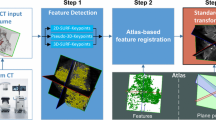Abstract
Purpose:
Fracture reduction and fixation of syndesmotic injuries is a common procedure in trauma surgery. An intra-operative evaluation of the surgical outcome is challenging due to high inter-individual anatomical variation. A comparison to the contralateral uninjured ankle would be highly beneficial but would also incur additional radiation and time consumption. In this work, we pioneer automatic contralateral side comparison while avoiding an additional 3D scan.
Methods:
We reconstruct an accurate 3D surface of the uninjured ankle joint from three low-dose 2D fluoroscopic projections. Through CNN complemented 3D shape model segmentation, we create a reference model of the injured ankle while addressing the issues of metal artifacts and initialization. Following 2D–3D multiple bone reconstruction, a final reference contour can be created and matched to the uninjured ankle for contralateral side comparison without any user interaction.
Results:
The accuracy and robustness of individual workflow steps were assessed using 81 C-arm datasets, with 2D and 3D images available for injured and uninjured ankles. Furthermore, the entire workflow was tested on eleven clinical cases. These experiments showed an overall average Hausdorff distance of \(2.4\pm 1.1\) mm measured at clinical evaluation level.
Conclusion:
Reference contours of the contralateral side reconstructed from three projection images can assist surgeons in optimizing reduction results, reducing the duration of radiation exposure and potentially improving postoperative outcomes in the long term.







Similar content being viewed by others
References
Court-Brown C (2006) Epidemiology of adult fractures: a review. Injury 37(18):691–697
Franke J, von Recum J, Suda AJ, Grützner PA, Wendl K (2012) Intraoperative three-dimensional imaging in the treatment of acute unstable syndesmotic injuries. J Bone Jt Surg 94(15):1386–1390
Elgafy H, Semaan HB, Blessinger B, Wassef A, Ebraheim NA (2010) Computed tomography of normal distal tibiofibular syndesmosis. Skelet Radiol 39(6):559–564
Mukhopadhyay S, Metcalfe A, Guha A, Mohanty K, Hemmadi S, Lyons K, O’Doherty D (2011) Malreduction of syndesmosis–are we considering the anatomical variation? Injury 42(10):1073–1076
Nakajima Y, Tashiro T, Sugano N, Yonenobu K, Koyama T, Maeda Y, Tamura Y, Saito M, Tamura S, Mitsuishi M, Sugita N, Sakuma I, Ochi T, Matsumoto Y (2007) Fluoroscopic bone fragment tracking for surgical navigation in femur fracture reduction by incorporating optical tracking of hip joint rotation center. IEEE Trans Biomed Eng 54(9):1703–1706
Zheng G, Yu W (2017) Statistical shape and deformation models based 2D–3D reconstruction. In: Zheng G, Li S, Székely G (eds) Statistical shape and deformation analysis. Academic Press, Cambridge, pp 329–349
Görres J, Brehler M, Franke J, Vetter S, Grützner P, Meinzer H-P, Wolf I (2016) Articular surface segmentation using active shape models for intraoperative implant assessment. Int JCARS 11(9):1661–1672
Varnavas A, Carrell T, Penney G (2015) Fully automated 2D–3D registration and verification. IEEE Trans Med Imaging 26(1):108–119
Gong RH, Güler Ö, Kürklüoglu M, Lovejoy J, Yaniv Z (2013) Interactive initialization of 2D/3D rigid registration. Med Phys 40(12):121911
Avendi M, Kheradvar A, Jafarkhani H (2016) A combined deep-learning and deformable-model approach to fully automatic segmentation of the left ventricle in cardiac MRI. IEEE Trans Med Imaging 30:108–19
Markelj P, Tomazevic D, Likar B, Pernus F (2012) A review of 3D/2D registration methods for image-guided interventions. IEEE Trans Med Imaging 16(3):642–661
Reyneke CJ, Luthi M, Burdin V, Douglas TS, Vetter T, Mutsvangwa TE (2018) Review of 2D/3D reconstruction using statistical shape and intensity models and x-ray image synthesis: towards a unified framework. IEEE Rev Biomed Eng 3333:1–17
Yu W, Chu C, Tannast M, Zheng G (2016) Fully automatic reconstruction of personalized 3D volumes of the proximal femur from 2D x-ray images. Int JCARS 11(9):1673–1685
Baka N, Kaptein B, de Bruijne M, van Walsum T, Giphart J, Niessen W, Lelieveldt B (2011) 2D–3D shape reconstruction of the distal femur from stereo x-ray imaging using statistical shape models. IEEE Trans Med Imaging 15(6):840–850
Novikov AA, Major D, Lenis D, Hladuvka J, Wimmer M, Bühler K (2017) Fully convolutional architectures for multi-class segmentation in chest radiograph. CoRR, arXiv:abs/1701.08816
Heimann T, Münzing S, Meinzer H-P, Wolf I (2007) A shape-guided deformable model with evolutionary algorithm initialization for 3D soft tissue segmentation. Inf Process Med Imaging 20:1–12
Goodall C (1991) Procrustes methods in the statistical analysis of shape. J R Stat Soc Ser B (Methodol) 53:285–339
Ronneberger O, Fischer P, Brox T (2015) U-net: convolutional networks for biomedical image segmentation. Med Image Comput Comput Assist Interv MICCAI 9351:234–241
Nolden M, Zelzer S, Seitel A, Wald D, Müller M, Franz AM, Maleike D, Fangerau M, Baumhauer M, Maier-Hein L, Maier-Hein KH, Meinzer H-P, Wolf I (2013) The medical imaging interaction toolkit: challenges and advances. Int JCARS 8(4):607–620
Kingma DP, Ba J (2014) Adam: a method for stochastic optimization. CoRR, arXiv:abs/1412.6980
Acknowledgements
This work was partially funded by Siemens Healthcare GmbH, Erlangen, Germany.
Author information
Authors and Affiliations
Corresponding author
Ethics declarations
Conflict of interest
All authors declare that they have no conflict of interest.
Ethical standards
All procedures performed in studies involving human participants were in accordance with the ethical standards of the institutional and/or national research committee and with the 1964 Helsinki Declaration and its later amendments or comparable ethical standards.
Additional information
Publisher's Note
Springer Nature remains neutral with regard to jurisdictional claims in published maps and institutional affiliations.
Rights and permissions
About this article
Cite this article
Thomas, S., Isensee, F., Kohl, S. et al. Computer-assisted intra-operative verification of surgical outcome for the treatment of syndesmotic injuries through contralateral side comparison . Int J CARS 14, 2211–2220 (2019). https://doi.org/10.1007/s11548-019-02043-8
Received:
Accepted:
Published:
Issue Date:
DOI: https://doi.org/10.1007/s11548-019-02043-8




